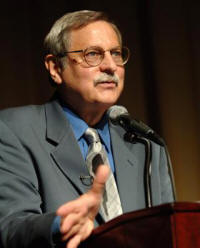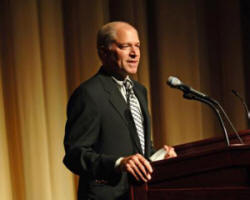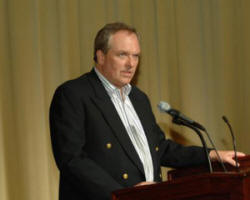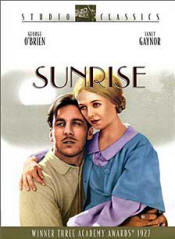Making movies. Enjoying movies. Remembering movies.
THE SCREENING ROOM
Related Articles:
|
By
Rick Mitchell

Recently retired UCLA
Preservation Officer Robert Gitt's presentations on film history and
technology are legends, and his presentation of two-thirds of his "A
Century of Sound" on Sept. 15, 2005 is a perfect illustration of why.
Given as part of the Academy of Motion Picture Arts and Science's
Science and Technology Council's "Sound In Motion Pictures" program, it
was the ultimate example of the Council's approach of doing programs
that are insightful for those in the know but easily accessible and
enjoyable for the general public.
Gitt had originally put this program together for AIMA about a decade
ago and originally it did literally cover a Century of Sound. However,
as the latter half of the Twentieth Century's advances in the use of
magnetic, stereo and digital sound was covered in the opening program
last June by Don Hall and Ioan Allen, Gitt restricted his program to a
"prequel" to those later developments.
As an archivist with the UCLA Film and Television Archives, Gitt has
been involved in the preservation and restoration of a lot of rare
material, some of which was included in the program. Most notably he has
been involved in tracking down and preserving elements of early sound
films done on Vitaphone and early disc systems whose picture or discs
are currently missing but hopefully will be found someday. Thus, the
program opened with the sound only of a promotional short made by Warner
Bros. in 1928 to be shown as the first night presentation for theaters
just wired for Vitaphone. It was hosted by Al Jolson and featured
speeches from Conrad Nagel, Monte Blue, and Dolores Costello among
others, all apparently reading somewhat nervously from cue cards,
especially Blue, an actor with no theatrical training. Jolson also
seemed to have had trouble reading from the cards, but typically kept
going off script with ad-libs. Interestingly, some early accounts of
those pioneering days have described Miss Costello's voice as recording
badly, but she sounded fine here.
 |
|
Host Robert Gitt |
Gitt then presents a
history of phonographic recording beginning with Edison, and including
some examples restored from Edison's cylinder recordings, and of
attempts by Edison and others to combine this technology with the
later-developed motion pictures. (W.K.L. Dickson did an experimental
sound film in the Black Maria of two Edison workers dancing while he
fiddled, the picture portion of which was included in Gitt's
presentation. The sound for this was found after his presentation was
put together and synced to the picture by Walter Murch; this clip opened
the Science and Technology Committee's first June presentation.) The
presentation included clips from two turn-of-the-Twentieth Century
French productions, one of which was a scene from "Cyrano De Bergerac,"
a 1913 drawing room comedy from Edison's second attempt at adding sound
to film, which he called the Kinetophone, and excerpts from work done in
a system devised by an Orlando Kellum that included a portion of "The
Merchant Of Venice" and D.W. Griffith's introduction to his "Dream
Street" (1921). (Does anyone know if Forties-Fifties sound man Terry
Kellum was related to this person?) All of these involved phonographs
behind the screen connected to the projector in the booth by various
complicated Rube Goldberg techniques, which were illustrated. The
picture portions had been optically printed to keep sync with the track
which had been recorded for playback at 90 fps; unfortunately, the speed
of original photography wasn't given.
All of these early efforts were recorded and played back acoustically,
that is, horns like those seen on old phonographs were used both to
gather the sound for recording as well as present the results to the
audience. In the mid-teens, two developments were to make possible the
revolution that was to occur in the next decade: the invention of
microphones that allowed for higher quality and more discrete recording,
and Lee De Forest's invention of tubes that would allow higher
amplification of sound in the theater.
In the Twenties, Bell Laboratories became interested in using phonograph
discs to add sound to motion pictures via a shaft connected to the
projector motor and developed what would be named Vitaphone when
licensed by Warner Bros. in 1926. Although Gitt uses the montage from
Warners' 1946 commemorative short "O.K. For Sound" to cover the 1926
Vitaphone opening night program (all but one or two of the "demo" pieces
have been restored), the other clips used are either rarities or
extended or different segments from pioneering films than are usually
shown, such as the extended sequence from "Don Juan" that follows the
Vitaphone demo clips and looks like it's off the original negative. He
then has a comedy sequence from Warners' second film released with a
Vitaphone music track, "The Better Ole," which also includes a whispered
word, "Coffee," which, surprisingly he makes no comment about. (The
third such Vitaphone release, "The First Auto" (1927) actually has a
couple of words spoken loudly, something discovered only when the film
was restored in the late Nineties.) "The Jazz Singer" is represented by
that film's first sound sequence, the cabaret scene in which Jolson says
"You ain't heard nothin' yet."
 |
|
Robert J. Heiber, President of Chace Productions |
(Interesting
historical aside: in the course of doing research for something else, I
was shocked to discover that in its review of "The Jazz Singer," Film
Daily not only did NOT mention the use of any dialog in the film, but
also did not report the kind of ecstatic first night audience reaction
described in other accounts. However, the dearth of Warner Bros.
advertising in the publication at the time, in the few issues from the
period that the Academy Library has, suggests there may have been
something internecine going on.)
Gitt concludes his section on disc recording with an extensive portion
of a trailer for the first "all-talkie," "The Lights Of New York"
(1928), which suggests that film was not as primitive as we've been led
to believe from the "take him for a ride" clip most commonly used, which
is in the 1950 Columbia/AMPAS short "The Sound Man," with which the
entire program concludes. He did get into the negatives of the disc
system, that the needles could only be used once, the discs could be
used only ten times, and illustrated a story told by Vitaphone pioneer
Stanley Watkins of what could happen if the projectionist was not
careful about keeping track of the reels and discs: how one night during
the "Don Juan"/shorts run, Will Hays opened his mouth on the screen and
guitarist Roy Smeck's voice came from the speakers! And if the heavy
disc was broken.... Gitt concludes the Vitaphone section with the only
surviving color clip from the two-color Technicolor feature "Sally"
(1929), additionally interesting because it has been restored from a
nitrate print with missing frames filled out by blowups from a 16mm
black-and-white print.
Gitt then delves into optical sound recording, again going back to the
earliest attempts, and here begins doing something very interesting:
having the clips projected so that the sound track is visible.
Essentially there were only two types of optical tracks: VARIABLE
DENSITY, in which the sound waves are recorded as horizontal lines of
varying thickness and density; and VARIABLE AREA, in which the sound is
recorded as peaks of varying shape and size emanating from a static
line. He includes graphic illustrations of the techniques used to do the
various types of recordings.
(For the record, as far as features were concerned, initially all of the
majors but RKO used variable density tracks, as would Warners when they
abandoned discs. Except for Hal Roach, most of the independents used the
RCA system, as would some 20th Century-Fox Bs and some lower-budgeted
Columbia and Universal films. In the early Thirties, a couple of "off
brand" re-recording systems, such as Powers Cinephone and Balsley and
Phillips, were used by independents but I've not been able to confirm
whether they used area or density tracks. One of the independents using
the RCA system was Mascot, and when it was merged into Republic, that
company continued to use RCA equipment, as would Disney after it signed
a distribution deal with RKO. In 1937, RCA improved its system and
Warner Bros. switched to it and would also continue to use it into the
late Seventies; into the early Eighties 16mm prints of new Disney,
Warner, and any films dubbed at the then Burbank Studios had RCA Duplex
tracks. Columbia also switched to RCA tracks in the mid-Fifties. In the
early Fifties, MGM adopted Western Electric's initial version of an area
track, a dual unilateral one and in 1954 Western Electric officially
switched to a dual bilateral area track that would be used by all but
one of its clients in the future and which would later become a
foundation for the Stereo Variable Area track. 20th Century-Fox
continued to use density tracks on its optical only 35mm and 16mm
prints, but apparently there were problems using these tracks on color
print stocks and when it began making combined "mag-optical" prints in
1956, Fox switched to area tracks for 35mm but continued to use density
tracks for 16mm until 1959.)
 |
|
Tad Marburg, chair of public programs for the Science and Technology Council |
Variable density was
the first system to enter popular usage, beginning with Lee De Forest's
Phonofilms, represented by a speech by "silent" Calvin Coolidge. When he
was still experimenting, De Forest had exchanged ideas with Theodore W.
Case and Earl I. Sponable, who were working along similar lines until
there was a falling out between them. (In the early Forties, Sponable
would write a long piece published in the SMPE Journal and elsewhere
debunking with exchanges of correspondence and other documentation De
Forest's claims to have been the inventor of modern sound technology.)
Case and Sponable would continue to work on their own and excerpts from
tests they made in 1926 were then shown. These tests, shot at different
speeds, would become a source of controversy among later technology
clueless film historians after they were used in a 1956 CBS "Twentieth
Century" episode entitled "The Movies Learn To Talk" because the
narration claimed that the higher pitch of Case's voice was due to the
tests having been shot "at the wrong speed for sound film." Of course,
THERE WAS NO OFFICIAL SPEED FOR SOUND FILM IN 1926, or, in actual
practice at the time, for silent film. In seeking to set a standard
speed for their disc system, Western Electric had done a survey of the
average speeds at which silent films were being photographed (between 18
and 22 fps) and projected (between 20 and 30 fps!) and settled on 24
fps/90 fpm (the latter for 35mm film) as an average. (Similar surveys
were done in 1925 by both the SMPE and Douglas Fairbanks with the same
results.) In their experiments De Forest, Case and Sponable, and later
RCA had all used slower speeds, causing Case's voice to sound higher
when played back at 24 fps. Actually, if the decision had been left up
to the sound engineers and based on what was best for audio quality, an
even higher speed, most likely 30 fps, would have been chosen; the
Dickson/Edison Kinetoscope used 40 fps. Because Vitaphone got into the
marketplace first, and also probably because the film companies had to
lease amplification equipment from Western Electric regardless of what
sound system they were using, 24 fps became the standard that exists to
this day.
The Case-Sponable system would be purchased by William Fox, who patented
it as the Fox-Case System but gave it the trade name Movietone. Like
Warners, Fox first used the system to add musical scores and sound
effects to existing silent films like "What Price Glory" (1926), and
"Sunrise" and "7th Heaven" (both 1927), a clip from the latter being
shown. But because the Movietone equipment was portable, unlike the
Vitaphone equipment, Fox was able to start a sound newsreel, and a
portion of the famous interview with George Bernard Shaw was shown. And
using Movietone trucks, director Raoul Walsh started the first primarily
outdoor film, "In Old Arizona" (1928); Walsh was injured during the
shooting and Irving Cummings finished the film.
 |
|
F.W. Murnau's "Sunrise" |
RCA introduced the
first VARIABLE AREA system which it called Photophone. Gitt showed a
portion of an unintentionally hilarious institutional promotion film on
this process featuring a scientist who is quite obviously uncomfortable
at being in front of the camera and has trouble finding something to do
with his hands. The program includes interesting and often hilarious
portions of some other institutional films used to explain sound movies
and the advances therein to the general public.
Although Warners reluctantly embraced sound on film for exhibition in
1930, it continued to do production recording on disc for another year
or so, dubbing by a Rube Goldberg technique described in better detail
by Scott Eyman in "The Speed Of Sound." Unfortunately this process was
apparently never photographed in action unlike the optical sound dubbing
process was in later years for "O.K. For Sound" and "The Sound Man."
Part One of the presentation concludes with the ending of "I Was A
Fugitive From A Chain Gang" (1932), one of the first Warner films to be
recorded and dubbed with optical tracks.
Though a bit more technically oriented, the second half of the program,
which deals with the efforts to improve sound quality between 1930 and
1950, was in some ways more interesting than the first. Both the density
and area tracks had problems, as did the recording, dubbing, and
playback systems. Gitt touched on the latter, which had been covered in
depth in the Science and Technology Council's second presentation on
microphones and speakers.
Gitt dealt more with the problems involved in getting acceptable sound
release prints. Both optical systems have very specific processing and
printing requirements that were illustrated with specially prepared
comparative clips.
Even in the earliest days, both types of tracks were capable of
recording a surprising range of frequencies at high and low volumes, but
this could be problematic at the theaters end because of variations in
their sound systems, acoustics, etc. In the late Thirties, an earlier
incarnation of the Academy's Science and Technology Council approached
this problem by doing a nationwide study and proposing an industry wide
standard for dubbing in which both extreme high and low frequencies
would be rolled off. Called the Academy Curve, it would be applied to
magnetic-to-optical dubs when they became standard in the mid-Fifties
and apparently is still applied to mono optical tracks. According to
sound historians Larry Blake and Marvin Walowitz, the Curve was not
applied to magnetic stereo dubs, and of course, not to Stereo Variable
Area dubs; through the Sixties, additional frequencies were reportedly
rolled off for 16mm track negatives on features, but not for TV shows.
In 1939, a test film was prepared with sample scenes from films released
by the eight major distributors for use by theater sound engineers in
tweaking the systems of different theaters.
Another problem which plagued both disc and optical systems was surface
noise from the playback medium. Various techniques developed in the
early Thirties reduced this for both optical systems, which led to the
dramatic use of variations in volume by the mid-Thirties. Rather than
rely on projectionists to do this during the show, methods involving
varying the amount of track information made available to the projector
sound head were developed to build these changes into the actual prints,
with notation in the leader that the sound fader was to be set 4 to 6 db
higher than was standard for a given distributor to prevent the quieter
moments from being played too low.
 |
|
One of the Linwood Dunn displays on sound |
With variable density
tracks, this involved the SQUEEZE TRACK, using vertical shutters in the
optical recorder, operated by a foot pedal under the dubbing panel, to
reduce the width of the track negative. The full 100 mil. area would be
used for big, loud moments like main titles, battles scenes, musical
numbers, but could be reduced to as little as 40 percent for more
intimate moments. The final scene of "Only Angels Have Wings" (1939) was
used to illustrate this, with the accompanying track shown. (Personal
note: Columbia may have been the only studio to use different variations
of width as squeeze tracks I've seen on films from other studios have
only used either 100 or 50 percent.)
For variable area tracks, RCA came up with a variation of this. In 1937,
to improve problems with projector sound head scanning of its unilateral
track, they had developed a method of reducing and printing the track
side by side with its mirror image to create what it called the DUPLEX
track. However, by masking off half the track, a volume reduction would
result and this was demonstrated by clips from "The Hunchback Of Notre
Dame" (1939) and "Citizen Kane" (1941). Unlike the variable density
squeeze track, these sections were apparently dubbed separately and
spliced together (splices were visible in the track) and this led to the
third method used, intercutting density and area tracks, as demonstrated
by the ending of "Rebecca" (1940). (NOTE: RKO may have been the only
studio to use this method as other sound historians who've interviewed
mixers from the period have stated that Warners used a separate pedal to
raise and lower the overall track volume as was done in recording
variable density squeeze tracks.)
Beyond that was further reducing noise as well as compensating for
losses in frequency response and dynamic range occur in the optical
re-recording process. By the Fifties, the industry would turn to
magnetic, in the early Seventies to Dolby and similar noise reduction
techniques, and ultimately digital to maintain sonic purity from
original recording to release print, but beginning in the late Thirties,
they were doing it quite successfully with the PUSH-PULL TRACK. For
this, two versions of the track would be recorded one in, one out of
phase. Played normally it sounds awful, but played through the
"decoder," only the basic sound modulations are heard, so not only are
any noises and scratches not audible, but the track can be played back
at higher volumes without overmodulating or lower volumes without
picking up surface noise. This was illustrated by a surviving music
track from "Gone With The Wind" (1939). Normally this was done with
standard 100 mil. tracks, but even more dynamic range was achieved by
using 200 mil. push-pull tracks as illustrated by a sound clip from
"Portrait Of Jennie" (1948).
Push-pull tracks were used for dubbing, the original Fantasound roadshow
version of "Fantasia" (1940) being the only known example of their usage
in an exhibition situation; the sound run from a separate dubber
interlocked with the projector.
(Illustrations of all the optical tracks described above can be found in
the Sound Wing of
www.widescreenmuseum.com.)
It should be noted that during the changeover to magnetic in the early
Fifties, a fair amount of production dialog and even music was still
being recorded on optical push-pull tracks, even for films that would be
released in magnetic stereo. The "stereo" CD of the original score for
"The Day The Earth Stood Still" (1951) was taken from 100 mil. optical
push-pull tracks that had been recorded multichannel. Mono sound effects
transferred from optical were still being used into the Eighties.
Another note: although Robert Gitt stated that the tracks he used had
not been cleaned up in any way, improvements in the sound chain,
especially in the as-close-to-state-of-the-art-as-possible Linwood Dunn
Theater, revealed a surprising level of sonic quality in these tracks
that would not have been heard even fifty years ago, a real tribute to
the pioneering engineers.
Gitt has actually prepared this program totally on film reels, with
silent material to allow for his narration, which makes for a smooth
presentation. It struck me that recent presentations by others which
combine clips and PowerPoint presentations were probably inspired by
this, really the only way to present film technology, and even film
history, to, especially, the general public.
Because I was not able to get on this immediately, I may have made some
errors and significant omissions, for which I apologize, especially to
Mr. Gitt. Hopefully, he will present this program, ideally in its
entirety, again. If so, don't miss it.
ADDENDUM (courtesy of
film restoration and preservation expert Scott MacQueen)
The Kellum pics may have run at 20 fps. The new printing negatives were
optically "slewed" by Pete Commandini of YCM Laboratories to play at 24
fps.
Cinephone was Variable Area.
The earliest Mascot sound films were serviced by the Disney Sound
Service using Cinephone portable equipment. This kept up in 1931 early
1932.
Disney went with RCA long before the RKO deal. They abandoned Cinephone
by Fall of 1932. The first production released in the format was "The
Night Before Christmas." It was also used for the "Parade Of The Award
Nominees," the 35mm in-color cartoon made for the 1932 Academy Awards.
The author would like
to thank the following for some of the additional information included
in the above: Larry Blake, Herbert E. Farmer, Bud Hoffman, Scott
MacQueen, Richard P. May, Edward R. Nassour, Phil Scott, Paul Rayton,
Marvin Walowitz.
Rick Mitchell is a film editor, film director, and film historian. He lives in Los Angeles.
© 2005 Rick Mitchell. All rights reserved
IMAGES: Top: "Good News" (1930); "Sunrise" ©20th Century Fox; Seminar photos are ©A.M.P.A.S. All rights reserved
